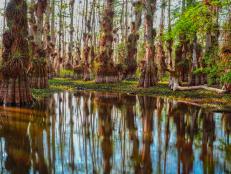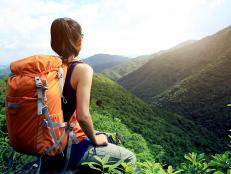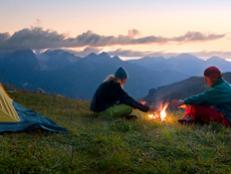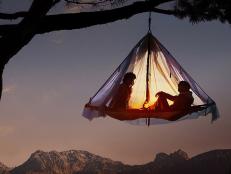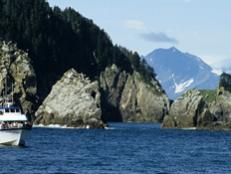10 Tips for Preserving the Great Outdoors by Leaving No Trace
Enjoy America's public lands while helping to keep them pristine for others with Travel Channel's tips for handling litter, dogs and basic trail etiquette.

Related To:
lessRelated To:
Leave No Trace
It’s exhilarating to venture into a landscape that looks as if no human has been there before. Leave No Trace is a set of principles developed by the non-profit Leave No Trace Center for Outdoor Ethics for enjoying America’s public lands while minimizing human impact. These guidelines have become the standard for mindfulness in the outdoors, and have been adopted by organizations including the National Park Service. As more and more people venture into the outdoors, working to limit impact keeps the wilderness pristine for the animals that live there and the humans who visit. Tread Lightly is another non-profit that promotes responsible outdoor recreation such as shooting, four-wheeling, and using drones on public lands. Read on for the principles of Leave No Trace, with the overarching theme of respect for America’s wild places.
See More Photos: How Not to Annoy Wild Animals at National Parks
Plan Ahead and Prepare
Planning ahead for your adventure keeps you and your party safe, and also allows mindful movement through the backcountry that minimally impacts the environment. Can you reduce the packaging of food to save weight and reduce trash that needs to be packed out? Do you have an accessible, sturdy bag for trash (such as a small dry sack), or a designated backpack pouch? Being familiar with your route beforehand reduces stress and allows you to more fully engage with your trip. It’s also a best practice to let someone not going on the trip know where you’ll be hiking or backpacking in case you're overdue. Know the 10 Essentials you'll need to pack on a day hike and enjoy an exciting, worry-free adventure.
Minimize Your Camp Footprint
By setting up camp in pre-existing or durable sites backpackers can help limit the wear and tear on the backcountry. Tent footprints can crush delicate vegetation, mosses and cryptobiotic soil, and it’s considered better to sacrifice one concentrated area than several. If there are no previously used sites where you are, examine the ground before pitching camp to see how you can minimally impact the area. It’s also recommended you establish the route to your bathroom area before it gets dark for safety and to minimize impact.
Stay On The Trail
Staying on the trail minimizes the number of trail scars in the wilderness, and it keeps hikers safe. If a section of trail seems impassable due to mud, do your best to minimize the detour such as stepping on rocks. In areas without trails, think about how you can best travel to least disturb plant life. Cairns — small stacks of rocks that mark trails or signal directional changes — should be left alone to help other hikers, and should not be built solely for aesthetic reasons.
Dispose of Litter Properly
Nobody goes into the backcountry expecting to litter, but litter is often found in the most remote areas. It’s easy to lose track of the corner of that energy bar you just opened, or to accidently have a tissue fall out of your pocket when you pull out your phone for a photo. Plastic water bottles are set down and forgotten, or can roll off a ledge during a lunch break. A handy, designated trash pouch keeps litter contained and help you focus on securing trash as opposed to stuffing it into your pocket (or missing your pocket altogether). It also makes it easy to pick up any trash you find, resulting in good trail karma. If you pack it in, please pack it out.
Leave What You Find
It's temping to take things you find on public lands as souvenirs, be it a cool rock or archaeological artifacts. But beyond being illegal to remove, taking things denies others the joy of finding them, too. And that person could be you next time. Please admire and photograph what you find, and then put it back so someone else can enjoy it. Take only photographs and leave only footprints.
Minimize Campfire Impacts
Campfires can be an awesome part of backpacking, but can also the most destructive thing done in the backcountry. Campfires cook the soil beneath them and it can take decades before plants can grow on that patch of ground again. Just as with pitching camp, it's best to sacrifice one area to campfires than many. No existing fire rings around you? Chose a spot that looks the least vulnerable to fire such as exposed rock, or consider forgoing a campfire altogether and using just a small camp stove. Make sure conditions are safe for a fire (no dry grasses nearby, no wind), and make sure your fire is dead out before moving on by pouring water onto the fire and stirring it into a mush with a stick. Also, be careful throwing trash into the campfire as most of the time it's the equivalent of littering.
Respect Wildlife
Encountering wildlife when camping is one of the coolest things that can happen. But when humans get too close to wildlife they chase animals out of their habitats and distrupt their habits. Even feeding small animals such as chipmunks and birds can train them to raid camps and chew through your backpack and tent. Bears and other animals that become accustomed to people and their food often have to be removed or even killed if they become too conditioned to interacting with humans. And getting that selfie with a wild animal often ends poorly.
Hiking With Your Dog
Your dog is awesome. But not everyone knows that, and wildlife certainly doesn't know that. Keeping your pet on a leash on public land is often the law, and it protects them from wildlife such as rattlesnakes and porcupines, possible traps where that's legal (or not), and other less well-behaved dogs. Leash rules vary throughout the public lands system so check beforehand. Pet waste is often required to be packed out, and waste bags and saddle bags make this easy to do.
Be Considerate of Others
Many people venture into the backcountry to enjoy the peace and solitude of nature by themselves or with friends. Sounds such as flowing water and the hooting of owls are part of the natural experience, as is a dark sky filled with stars. As technology continues to shrink and more people are encouraged to venture into the backcountry by social media, conflicts between campers are on the rise. Portable speakers allow people to blast their music and small devices can now flood a camp with light. More people on the trail means more encounters in tight spots and favorite camp spots. The National Park Service offers tips on trail courtesy that include allowing uphill hikers the right-of-way, keeping your music volume down when others are present and having larger groups walk single file.
Don't Vandalize
Painting on or carving into trees, rocks and structures on public lands may seem like a poetic or romantic impulse at the time (such as this heart and initials at Grand Canyon National Park), but it’s graffiti that takes away from other visitors’ experiences and damages natural and archaeological sites. Rangers and volunteers do the best they can to remove and repair graffiti throughout public lands, and vandals are fined and even sentenced for their graffiti. Some may be motivated to make their mark proclaiming their existence through graffiti and even share their work on social media, but this only spoils the natural beauty for others. Please resist any temptation to deface public lands.
